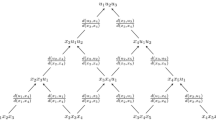Abstract
Thin plate splines are highly useful for the approximation of functions of two variables, partly because they provide the interpolant to scattered function values that minimizes a 2-norm of second derivatives. On the other hand, they have the severe disadvantage that the explicit calculation of a thin plate spline approximation requires a log function to be evaluatedm times, wherem is the number of “r 2logr 2” terms that occur. Therefore we consider a recent technique that saves much work whenm is large by forming sets of terms, and then the total contribution to the thin plate spline from the terms of each set is estimated by a single truncated Laurent expansion. In order to apply this technique, one has to pick the sets, one has to generate the coefficients of the expansions, and one has to decide which expansions give enough accuracy when the value of the spline is required at a general point of ℓ2. Our answers to these questions are different from those that are given elsewhere, as we prefer to refine sets of terms recursively by splitting them into two rather than four subsets. Some theoretical properties and several numerical results of our method are presented. They show that the work to calculate all the Laurent coefficients is usuallyO(m logm), and then onlyO(logm) operations are needed to estimate the value of the thin plate spline at a typical point of ℓ2. Thus substantial gains over direct methods are achieved form⩾200.
Similar content being viewed by others
References
I. Barrodale, R. Kuwahara, R. Poeckert and D. Skea, Processing side-scan sonar images using thin plate splines, Numer. Algor. 5 (1993), this volume.
B.J.C. Baxter, The interpolation theory of radial basis functions, Ph. D. dissertation, University of Cambridge (1992).
R.K. Beatson and G.N. Newsam, Fast evaluation of radial basis functions: I, Comp. Math. Appl. 24 (1992) 7–19.
M.D. Buhmann, Multivariate cardinal interpolation with radial basis functions, Constr. Approx. 6 (1990) 225–255.
J. Duchon, Splines minimizing rotation-invariant seminorms in Sobolev spaces, in:Constructive Theory of Functions of Several Variables, Lecture Notes in Mathematics 571, eds. W. Schempp and K. Zeller (Springer, Berlin, 1977) pp. 85–100.
L. Greengard and V. Rokhlin, A fast algorithm for particle simulations, J. Comp. Phys. 73 (1987) 325–348.
M.J.D. Powell, Tabulation of thin plate splines on a very fine two-dimensional grid, in:Numerical Methods in Approximation Theory, Vol. 9, eds. D. Braess and L.L. Schumaker (BirkhÄuser, Basel, 1992) pp. 221–244.
Author information
Authors and Affiliations
Rights and permissions
About this article
Cite this article
Powell, M.J.D. Truncated Laurent expansions for the fast evaluation of thin plate splines. Numer Algor 5, 99–120 (1993). https://doi.org/10.1007/BF02212042
Issue Date:
DOI: https://doi.org/10.1007/BF02212042



